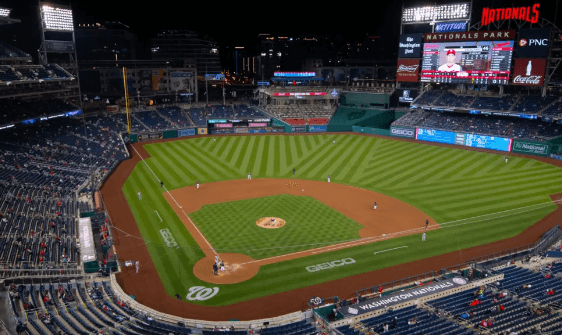
How Many Innings In Baseball
Baseball, a beloved American pastime, is a game steeped in tradition and strategy. One of the fundamental aspects of baseball is the concept of innings, which determines how many opportunities each team has to bat and play defense. Read more
Innings serve as the building blocks of a baseball game, providing a systematic way for teams to alternate between offense and defense. Each inning consists of two halves – one where the home team bats and the other where the visiting team takes their turn at bat. The objective for both teams is to score runs during their offensive half-inning while preventing their opponents from doing so during their defensive half-inning. These alternating turns at bat ensure fairness and equal opportunities for both teams to showcase their skills on offense and defense.
The standard length for a professional baseball game is nine innings, with each team having an opportunity to bat nine times if necessary. However, it’s important to note that this regulation can be altered in certain circumstances such as rain delays or tie games. In these cases, extra innings may be played until there is a winner or until conditions allow for completion.
Extra innings not only provide an extended thrill for players and fans alike but also add an element of unpredictability to the game. Whether it’s experiencing the tension of tied scores or witnessing historic extended play games, baseball enthusiasts are constantly reminded why this sport captivates them with its unique blend of strategy and skillful execution.
Regulation Game Length and Structure
A regulation baseball game consists of nine innings, with each team taking turns batting and fielding until three outs are recorded per inning.
However, in certain circumstances such as a tie score at the end of nine innings or inclement weather conditions, the game can go into extra innings. Overtime rules in baseball dictate that additional innings will be played until a winner is determined.
Factors that can affect the length of a baseball game include the number of runs scored, the pitching performance of both teams, and the strategic decisions made by managers. High-scoring games with multiple pitching changes and lengthy at-bats can prolong the duration of a game, while low-scoring games with dominant pitching performances tend to be shorter.
Additionally, delays caused by injuries, challenges to umpire calls, or weather interruptions can further extend the length of a game.
Overall, while a regulation baseball game consists of nine innings, various factors can influence its length and potentially lead to overtime play.
Understanding the Basics of an Inning
One of the fundamental components of a baseball game involves dividing it into distinct segments known as innings. Each inning consists of two halves, with the home team batting in the bottom half and the visiting team batting in the top half.
The importance of scoring runs and preventing the opposing team from doing so drives strategies for getting outs. In each half-inning, both teams strive to score as many runs as possible by hitting the ball safely and advancing around the bases.
Conversely, defensive teams aim to get three outs by various means such as striking out batters, catching fly balls, or tagging runners out. Learn more
This back-and-forth dynamic between offense and defense creates an engaging and strategic aspect of baseball that keeps fans enthralled throughout the game.
Each Team’s Turn at Bat and in the Field
In the game of baseball, each team takes turns at bat and in the field, with one team batting while the other plays defense. The order in which players from a team take their turn at bat is determined by the batting order, which is often decided by the coach or manager based on various factors such as skill level and strategy.
The defensive positions are also crucial in baseball, as they determine where each player should be positioned on the field to maximize their ability to make plays and prevent runs. Some common defensive positions include pitcher, catcher, first baseman, second baseman, third baseman, shortstop, and outfielders. Each position has its own unique responsibilities and requires different skills to excel.
Overall, understanding both the batting order and defensive positions is essential for a successful game of baseball.
The Traditional Nine-Inning Game
The traditional nine-inning game consists of two teams alternating between offense and defense, with each team having the opportunity to score runs and prevent their opponents from scoring.
This format has been a staple of baseball since its inception, with the first documented nine-inning game taking place in 1859.
The length of nine innings allows for a balanced and strategic game, where teams must carefully manage their resources and make strategic decisions to secure victory within the allotted time frame.
Over the years, various strategies have been developed to maximize success in a nine-inning game. Pitching rotations, bullpen management, defensive alignments, and offensive strategies all play a crucial role in determining the outcome of a game.
Teams must carefully plan their approach to each inning, taking into account factors such as pitch count, base runners, and potential pinch-hitting opportunities.
The history of nine inning games shows that they have become synonymous with baseball itself, providing fans with an exciting and engaging experience while also allowing players to showcase their skills and compete for victory within a defined timeframe.
Exploring Extra Innings and Tie Games
Exploring the dynamics of extended play and unresolved outcomes adds an element of suspense and uncertainty that captivates baseball enthusiasts.
In extra innings, teams must employ specific strategies to maintain their competitive edge. Pitching becomes a crucial factor, as bullpen depth and management come into play. Teams need to carefully plan their relief pitchers’ usage to prevent fatigue and maximize effectiveness. Additionally, offensive strategies may change as players adjust their approaches to capitalize on scoring opportunities in high-pressure situations.
The impact of tie games on playoff standings cannot be underestimated either. A single tie game can have far-reaching consequences for teams vying for postseason spots, as it affects their win-loss records and potentially alters the entire landscape of the playoff race. Consequently, teams are often motivated to push harder in extra innings, knowing that a victory could significantly boost their chances of advancing in the standings.
Overall, these elements contribute to the allure of extended play and unresolved outcomes in baseball, making each extra inning or tied game a thrilling experience for both players and spectators alike.
Famous Extended Play Games in Baseball History
Famous extended play games in the history of baseball have showcased the resilience and determination of teams as they navigate through intense, prolonged battles on the field. These marathon games have captivated audiences with their sheer length and unpredictability, often testing the endurance and mental fortitude of players.
One such famous game is the 1981 match-up between the Pawtucket Red Sox and Rochester Red Wings, which lasted for a staggering 33 innings over the course of three days. This epic battle required both teams to employ unique strategies to stay competitive and ultimately secure victory.
In extra innings, teams often prioritize pitching depth, as fatigue becomes a significant factor for both starters and relievers. Managers must carefully manage their bullpen resources, making strategic decisions on when to make substitutions or change pitchers. Additionally, hitters need to adjust their approach at the plate, focusing on situational hitting rather than relying solely on power or individual performance.
These games serve as reminders that success in extra innings requires not only physical skill but also mental resilience and strategic acumen from both players and managers alike.
The Thrill of Nail-Biting Finishes
Nail-biting finishes in baseball games provide an exhilarating experience for both players and fans, showcasing the intense competition and unpredictability of the sport.
The tension of close scores adds to the excitement as every pitch and play can potentially turn the tide of the game. Read more
It is during these nail-biting moments that clutch performances become crucial. Whether it’s a pitcher striking out a batter with bases loaded or a hitter delivering a game-winning home run in the final inning, these clutch performances highlight the significance of individual skill and mental fortitude in high-pressure situations.
Fans are captivated by these thrilling finishes because they not only demonstrate the talent and athleticism of the players but also remind us of our own desire for freedom – that feeling of breaking free from expectations and achieving something extraordinary.
Frequently Asked Questions
How many innings are played in a baseball game?
Baseball games consist of nine innings, with each team getting the opportunity to bat and field. However, if the game is tied at the end of nine innings, extra innings can be played until a winner is determined.
What happens if a game is tied after nine innings?
The rules for extra innings in baseball state that if a game is tied after nine innings, additional innings are played until there is a winner. A game cannot end in a tie.
Can a team score multiple runs in a single inning?
Teams can indeed score multiple runs in a single inning, utilizing various scoring strategies such as hits, walks, and home runs. Inning records showcase notable instances of high-scoring innings throughout baseball history.
How many players are on the field for each team during an inning?
During an inning in baseball, each team has nine players on the field. These players assume different defensive positions such as pitcher, catcher, infielders, and outfielders. Substitutions can be made throughout the game to replace players if needed.
Are there any time limits on how long a baseball game can last?
Baseball games have no fixed time limits, allowing them to potentially last for hours. The duration is determined by the number of innings played and factors such as pitching changes, timeouts, and game situations.
Conclusion
In conclusion, the length of a regulation baseball game is typically nine innings, with each team having a turn at bat and in the field. This structure allows for equal opportunities for both teams to showcase their skills and compete against one another.
However, there are instances where games can go into extra innings if the score is tied at the end of nine innings. These extended play games add an element of excitement and uncertainty to the sport, as they require teams to continue playing until a winner is determined.
Some famous extended play games in baseball history have captivated fans worldwide due to their nail-biting finishes and incredible displays of skill. These games serve as reminders of the unpredictable nature of baseball and its ability to create unforgettable moments.
Overall, baseball’s inning structure contributes to its unique charm and strategy. Whether it’s a traditional nine-inning game or an exciting extra-inning battle, each inning brings new possibilities and challenges for players and fans alike. The combination of skill, strategy, and suspense makes baseball an enduringly popular sport that continues to captivate audiences around the world.


